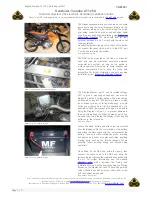
Installation of UV Disinfection System
7.
Once it is determined that there are no leaks, plug the system into the ground fault interrupter and check controller to
ensure the system is operating properly. The controller should illuminate without any alarms.
Note:
DO NOT look directly at the glowing UV lamp.
8.
Allow the water to run for a few minutes to clear any air or dust that may be in the chamber.
Note:
When there is no flow, the water in the cell will become warm, as the UV lamp is always on. To remedy this, run a
cold water tap anywhere in the house for a minute to flush out the warm water.
3.1 Disinfection Procedure
UV disinfection is a physical disinfection process and does not add any potentially harmful chemicals to the water. As UV
does not provide a disinfection residual, it is imperative that the entire distribution system located after the UV be chemically
disinfected to ensure that the plumbing system is free from any bacteriological contaminants. The disinfection process must
be performed immediately after the UV unit is installed and repeated thereafter whenever the UV is shut down for service,
without power, or inoperative for any reason. The procedure for sanitizing the plumbing system is readily accomplished as
follows:
1
•
Ensure the controller is
plugged in for entire
disinfection process.
2
2
1
2
2
2
•
Shut off the water supply.
•
Close each faucet.
3
1
2
•
Remove filter cartridge(s).
4
Household 5.25%
Bleach Solution
BLEACH
x2
2
•
Pour 2 cups of household
bleach solution into the filter
housing(s).
Note:
DO NOT use
Hydrogen Peroxide.
•
Re-install the housing(s).
5
2
1
2
2
2
•
Turn on the cold water
supply.
•
Open each faucet and all
water openings until you
smell the bleach and then
6
2
1
2
2
2
•
Turn on the hot water supply.
•
Open each faucet and all
water openings until you
smell the bleach and then
close the faucets.
7
2
3
1
0
30
15
45
30 mins
•
DO NOT use water for 30
minutes.
•
Flush the system until no
chlorine smell is detectable
and reinstall the filter
cartridge(s).
Notes:
1) The addition of chlorine (bleach) to a hot water tank that has in the past been fed with untreated raw water with
high levels of other contaminants (iron, manganese, hydrogen sulphide, organics, etc.) will result in oxidation
of these contaminants and may require repeated flushing of the hot water tank. This contingency must be
dealt with independently under the start-up procedure for any other conditioners that may form a part of the
pre-treatment for the UV unit.
2) The above disinfection procedure will result in a massive chlorine residual far in excess of the 0.5 to 1.0 mg/L
typically present in municipally chlorinated water and of a magnitude consistent with the minimum 50 mg/L
chlorine solution recommended for the disinfection of distribution systems known to be contaminated. Do not
consume water until complete system has been flushed
.
PUESTA A CERO DEL
TEMPORIZADOR/
DESPLAZAMIENTO
PUESTA A CERO DEL
TEMPORIZADOR/
DESPLAZAMIENTO
8
Summary of Contents for SC200-A
Page 1: ...Owner s Manual Powered by Models SC200 A SC410 A 520192 R_RevK...
Page 15: ...Supporter par Mod les SC200 A SC410 A Manuel d utilisation Supporter par 520192 R_RevK...
Page 29: ...Desarrollado por Modelos SC200 A SC410 A Manual del propietario Desarrollado por 520192 R_RevK...
Page 43: ...43 Esta p gina est en blanco de forma intencional...









































